Using Catalog Ads as a Sports & Fitness brand
January 29, 2024

If you're a sports or fitness brand that runs Catalog Ads on Meta, then this playbook is designed just for you!
We've dug through thousands of ads from leading sports and fitness retailers, and have collected some of the best to help explain how you too can create Advantage+ Catalog ads for your business.
Of course, the following tactics and strategies aren't meant to be copied and pasted, but instead, should be used as inspiration to help improve your Catalog Ads.
Take for example the following Catalog Ad from Under Armour, where they've included their logo in each ad to improve the overall design, and keep things more cohesive. However, logos aren't the only bits of branding you can use. You can also use your brand's name, colors, mission, values, or tone of voice to create consistently relevant and on-brand Catalog Ads.

We've found that most sports and fitness brands are focusing on the following areas: always-on Catalog Ads, Campaigns, and Sales.
So, if you can take away just a handful of their tactics and implement them into your own Catalog Ads, you'll be well on your way to advertising success!
The most used product fields in Catalog Ads designs:
The moderately used product fields in Catalog Ads designs:
The rarely used product fields in Catalog Ads designs:
Table of Contents
Always-on Catalog Ads for sports brands
Always-on Catalog Ads refer to your ads that are always running, the ones that are always being displayed to your audience, and the ones that you'll want to spend the most time and energy (and ad spend) perfecting!
Generally, always-on Catalog Ads consist of content that's evergreen, which means that no matter who sees them or when they see them, the content will still be relevant.
And the good news is that there are a ton of different ways that sports and fitness brands are creating extremely compelling, effective, Advantage+ Catalog Ads!
Let's take a look!
Branded sports and fitness backgrounds and logos
From logos to branded color palettes, sports and fitness business can easily leverage their existing branding to instantly create more relevant, more compelling Catalog Ads.
Instead of just showing the product against a white background, Gymshark includes the logo, as well as a branded background and the product category to ensure that all of their ads are similar and on-brand.

Here's another advertiser that is doing much of the same as Gymshark, but on top of that also thinking about using color theory to evoke different emotions and feelings into their viewers.
.jpg)
For instance, blue is a color that evokes a sense of trust and reliability, whereas red can be used to evoke a sense of action, desire, or even danger!
Benefits:
- Sports and fitness brands can use their existing brand assets, from logos and color palettes to company values or their mission statements to create relevant always-on Catalog Ads.
- Color theory can help boost Catalog Ad performance by evoking all sorts of different feelings and emotions.
Disadvantages:
- Using brand assets won't work as well if your business isn't well-known.
Red and yellow are typically great colors to grab attention. And this can be very useful if you have great offers - like Foot Locker has in their Catalog ad below, where they offer a voucher with 15% off for first-time buyers.
A great ad to run in your top funnel, when you want to find new customers - showing the products they are most likely to buy with an offer they can't refuse:
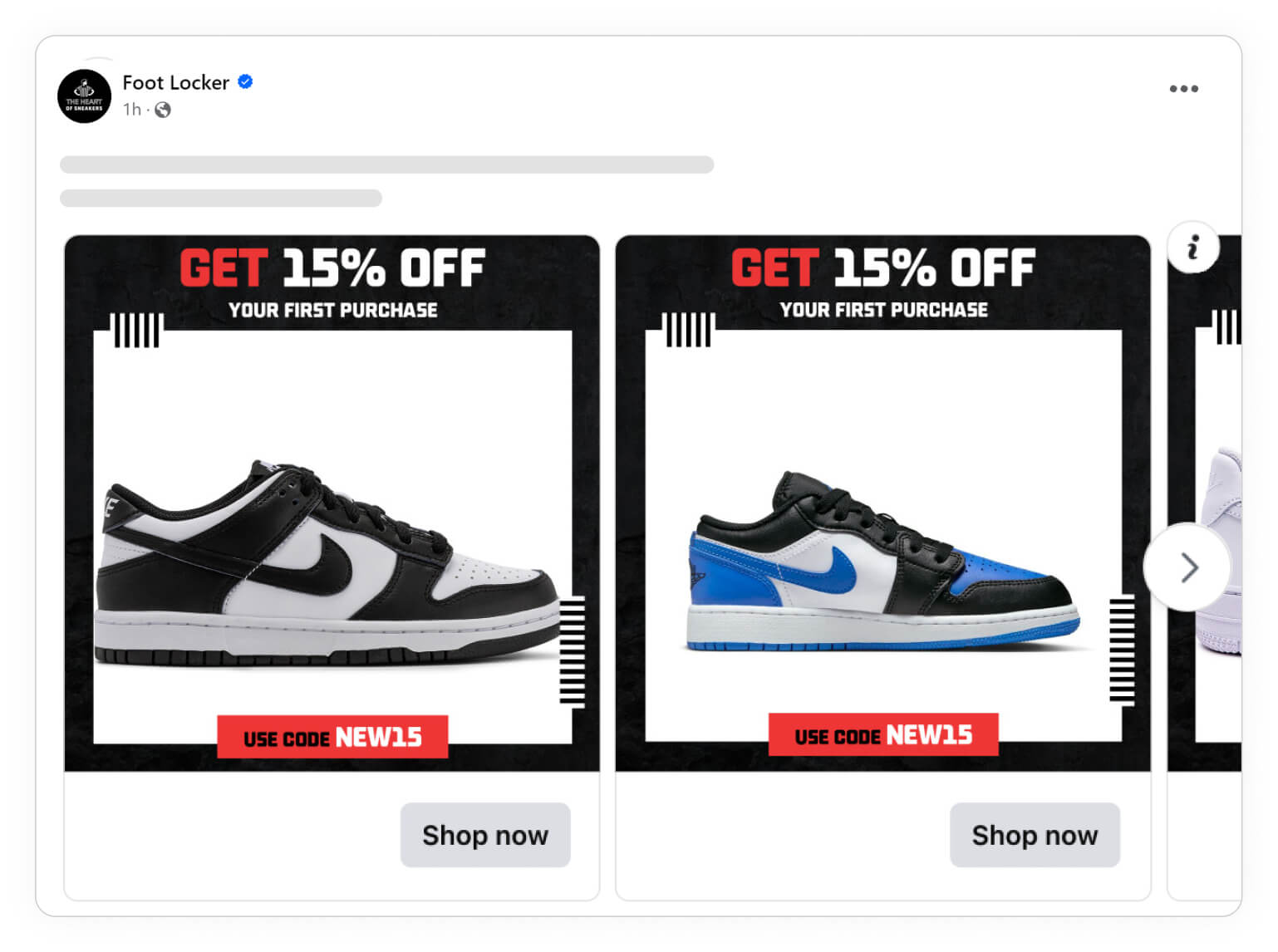
Showing benefits in your Catalog Ads
Another way to improve your Catalog Ads can be to show the benefit of the product - or how it is used in real life - instead of the packshots of the products. It's especially helpful for many sports brands where the usage fits perfectly to the more lively and active nature of sports.
Here is an example of GARMIN showing their products in use, instead of just the product, making their catalog ads feel more alive:
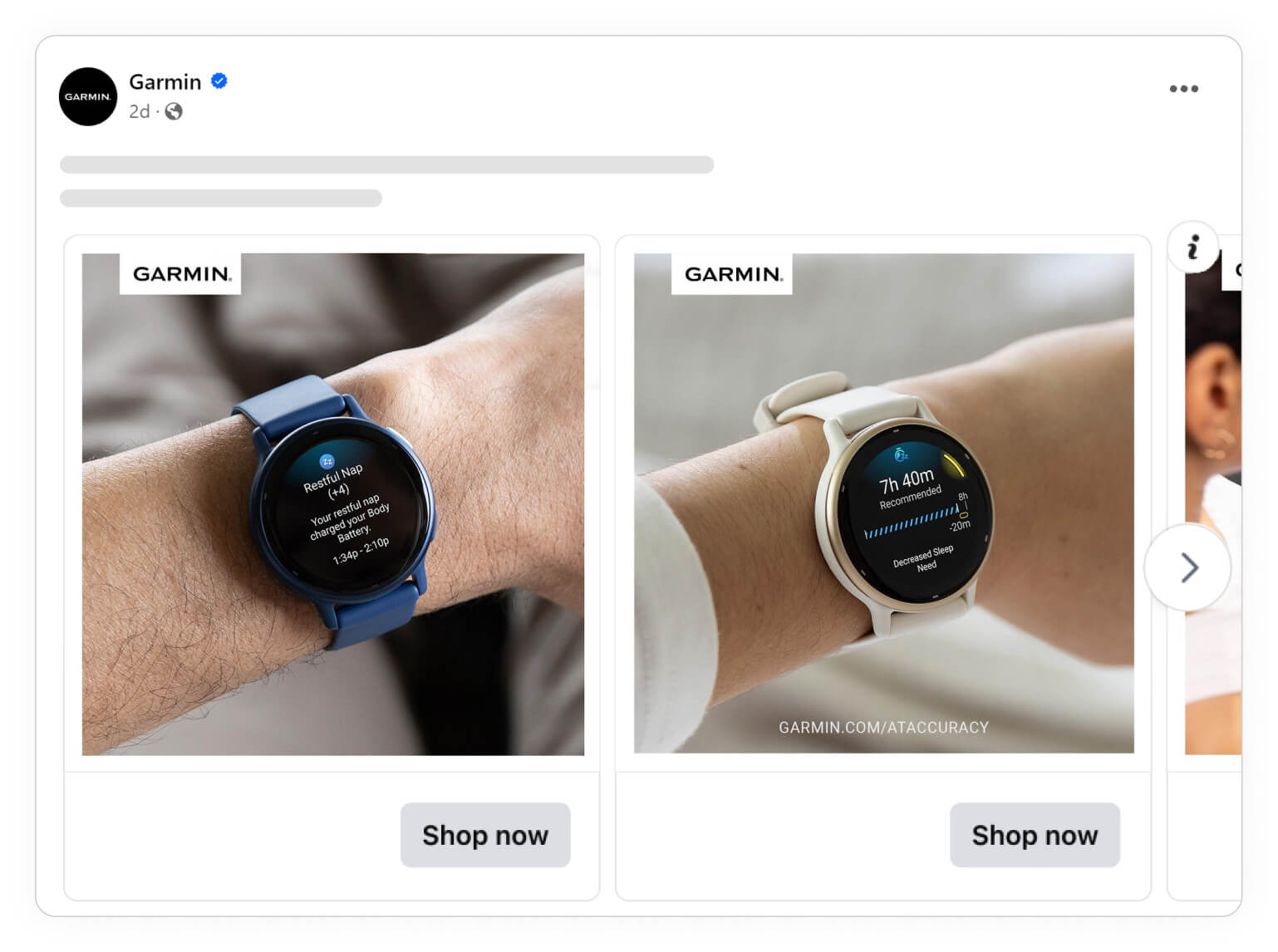
Many sports retailers and brands already have these images available for their products in "additional images", so it's typically easy to implement in some of your ads and see how it performs for certain audiences.
A way to show the feeling of benefit and usage if you only have packshots available is to make category-specific designs. This can be by making a design for each sport (one design for football, a different one for basketball, and a third design for running).
Here we have another example from GARMIN, where the background changes dynamically based on the sport the product was designed for:
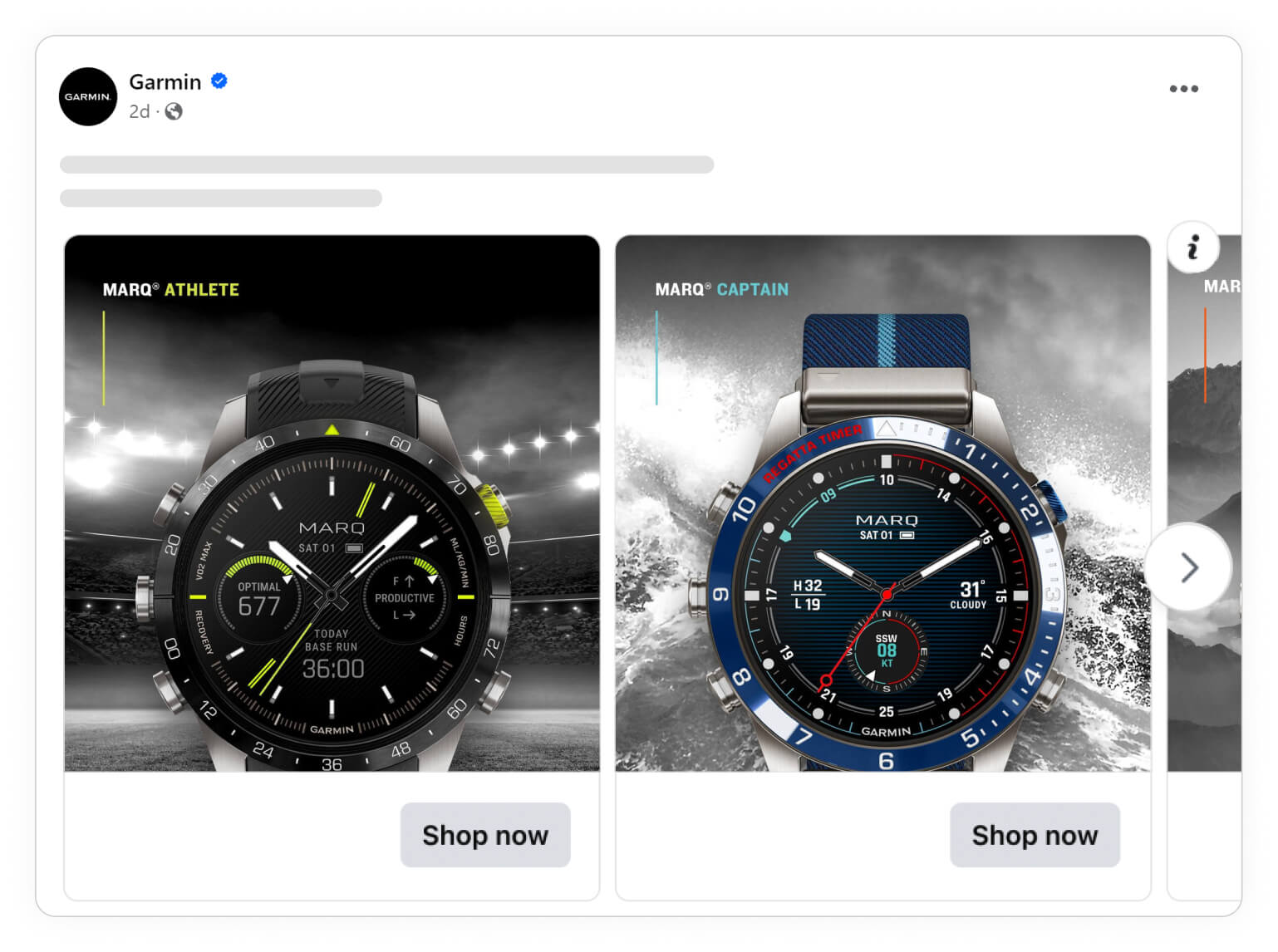
Showing benefits and use cases of the products can make it easier for your viewers to understand how your products can help them achieve their goals. It's a great way to showcase how this product will support the consumer in their life and sport.
Using product information for Sports and Fitness Catalog Ads
Depending on the products that you're selling, product information can mean all sorts of different things, ranging from product sizes and dimensions, to pricing, colors, or even the product's name. It really just depends on the products that you're advertising and the data that you have available to you.
Regardless, the trick is that you're only going to want to include product information that's valuable and relevant to your target audience.
For example, and just like the following Catalog Ad example, sports brand can include product information, such as the price and brand of the products they're promoting.
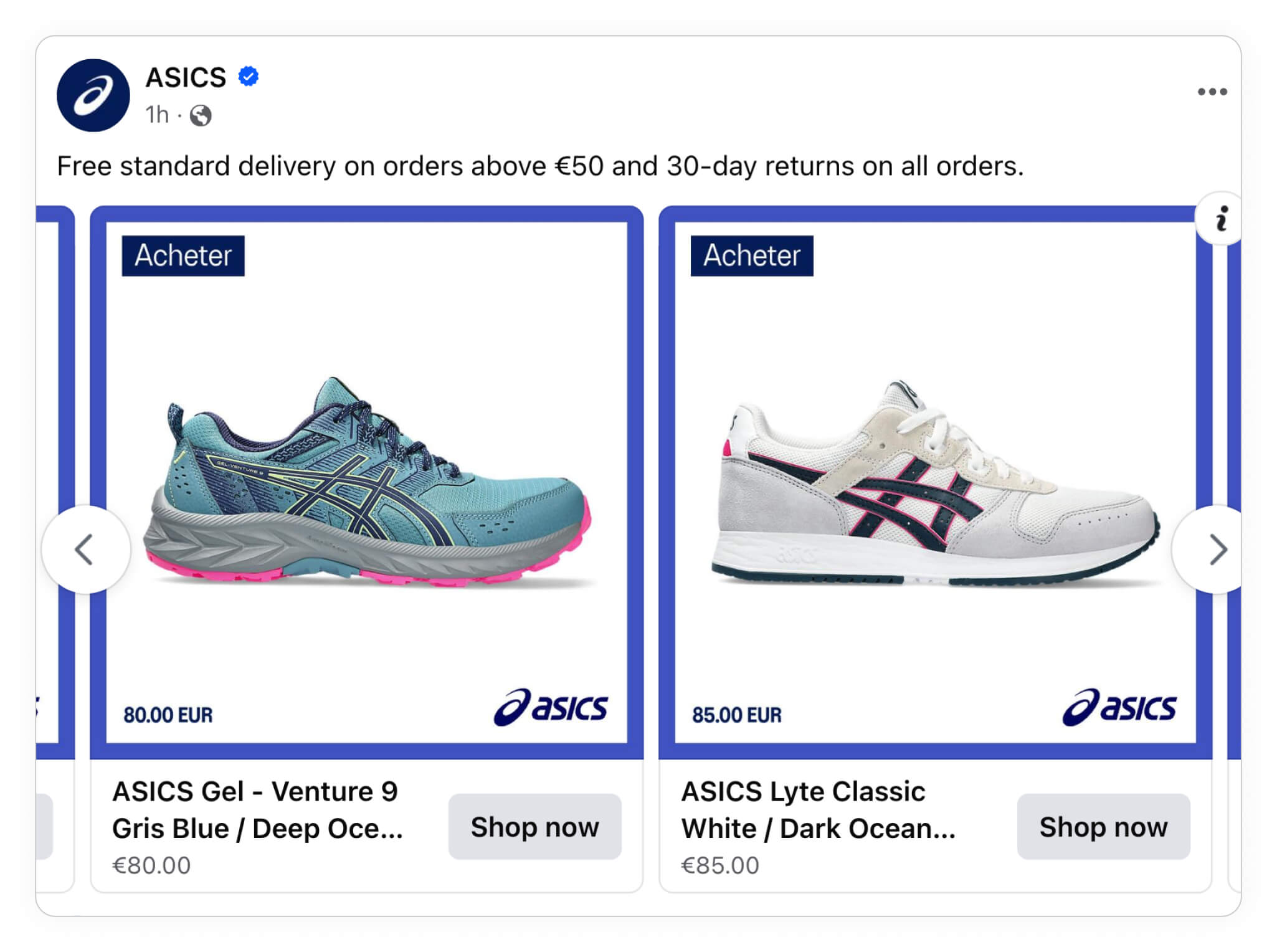
Including product information doesn't only help your ads better describe the product. They also help you screen and qualify your viewers so that you'll have higher quality traffic clicking on your ads and landing on your site.
Better quality traffic = better chance at making the sale.
Which product information that is relevant typically depends on the product categories you are selling. A great example of this is how Pricerunner showed the 4 important informations when buying running shoes:
- Is this a great shoe? (rating in the top corner)
- What brand is it from? (brand name)
- Do they have it in my size? (all sizes are shown)
- And finally, what is the price (oh, it's on sale right now!)

Depending on the type of sports or fitness products that you're selling, product names can also be considered valuable information. However, it really depends on the type of products.
So for instance, if you're selling sports clothing or t-shirts, showing the products name won't be all that relevant. But, like the following Catalog Ad example, if you're selling high-end sneakers, showing the products name can and will help qualify your viewers.

Again, the key is to always include product information that is relevant to your viewers. And the more relevant information you include, the better you will screen and qualify the people who land on your site.
In the following example, this sports and fitness advertiser combined the products' names, branding, price, and a few other elements to create a perfect catalog ad, complete with virtually all the information a viewer might want to know.

Alternatively, you can also use product attributes, such as the package size or product quantity, just like in the following Catalog Ad from Body&Fit.
The trick is to use information and data that you already have about your products so that you can easily implement this valuable information into your ads.

And you don't always have to do this in the same way! In the following Catalog Ad, this sports advertiser highlights their product information by using a visual element.
The colored banner, which isn't only a good way to leverage existing information, but it's also a good way to use color theory and high-contrast to attract viewer attention to certain elements of the ad.
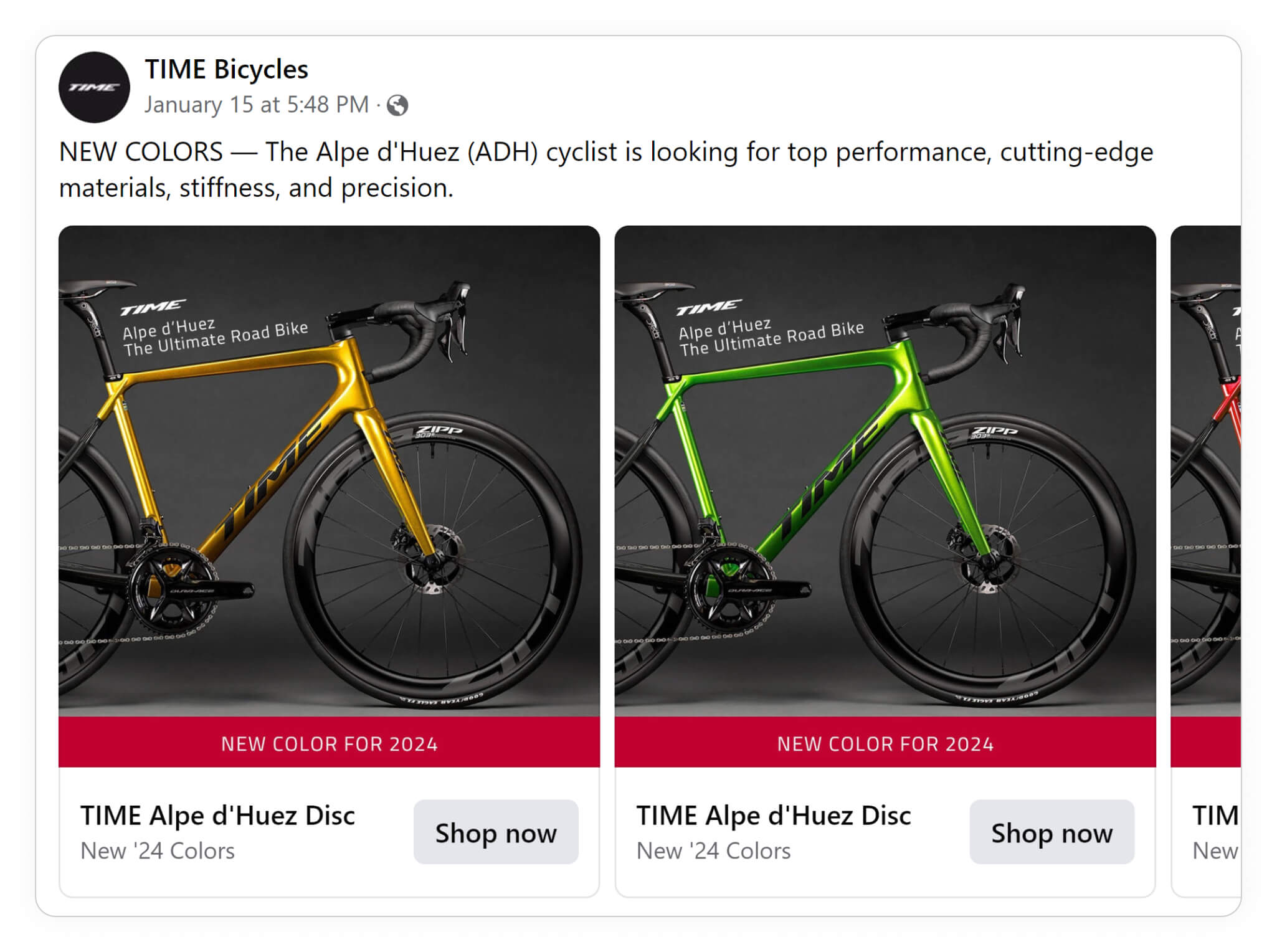
Benefits:
- Product information is valuable information that can help you screen viewers and improve the quality of the traffic that lands on your site.
- You can use information and data that you already have to improve the quality of your Catalog Ads.
Disadvantages:
- Your Catalog Ads have a limited canvas space, and you don't want to include too much information that makes them seem cluttered or crowded.
Show additional images
When it comes to sports and fitness products, additional images can really help show off the usefulness and quality of your products. In fact, you might argue that when selling sports apparel and clothing, images are the MOST relevant information you can include in your ads!
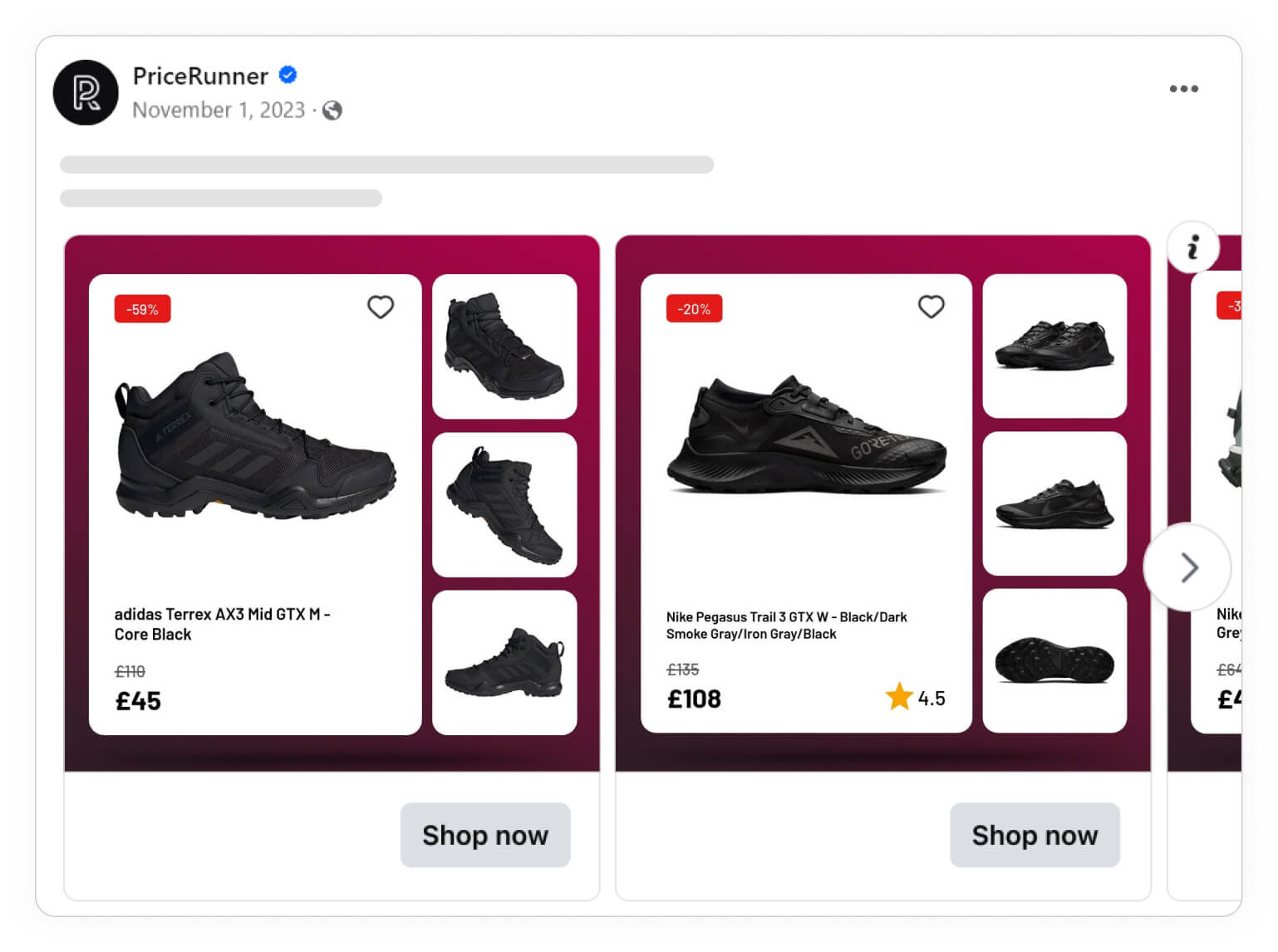
But, you shouldn't just force yourself to only show products against a plain, white background. Not only is that boring, but it might not add a lot of value to your content. Instead, you might want to use additional images, like the following Catalog Ad example from Live!, where they show different models, wearing different outfits, and posing in different stances.
Models are already a great way to make your products seem more desirable and relevant, but we also love the way this advertiser used additional images to show off the shape and quality of their items.
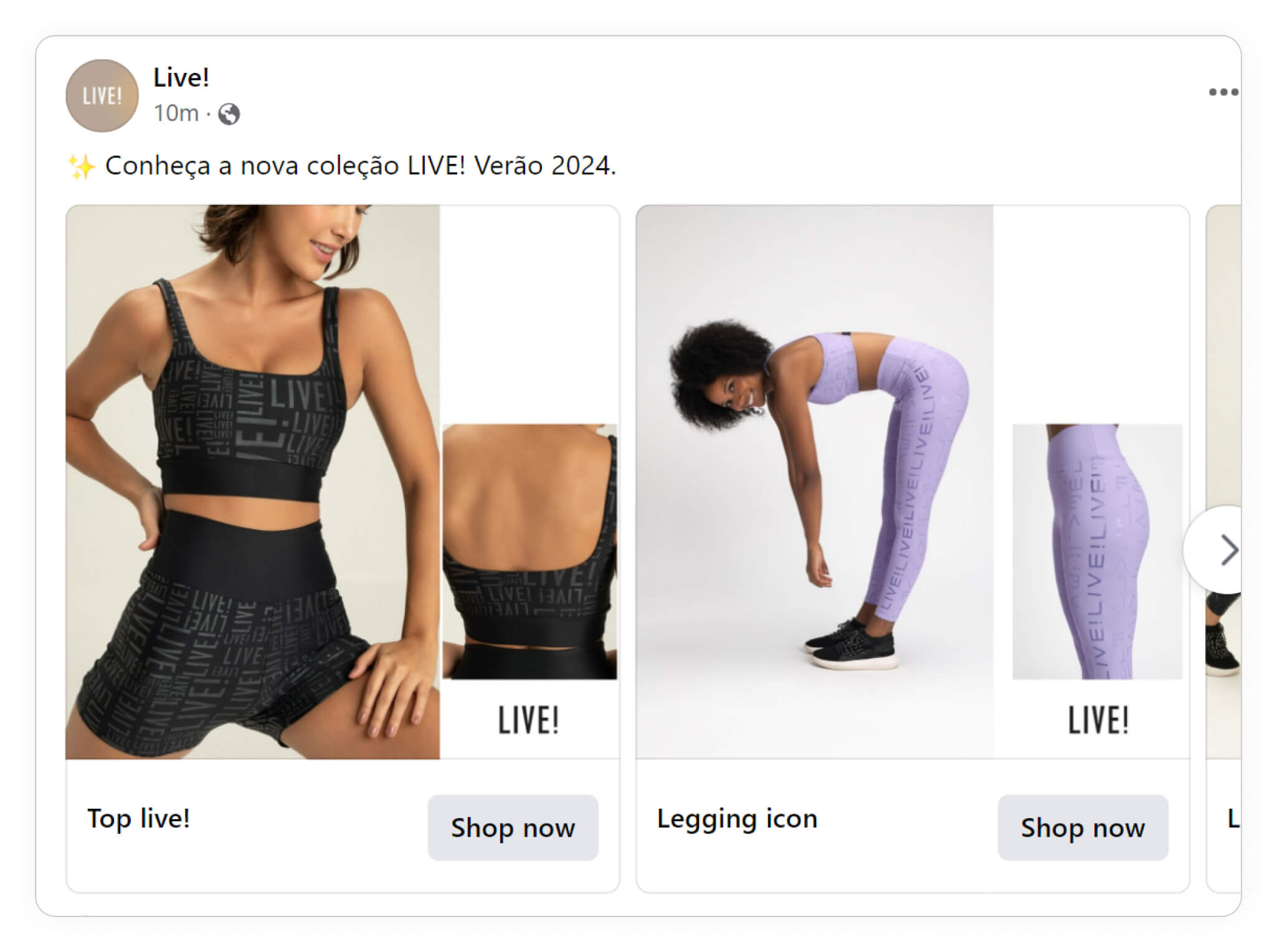
Alternatively, the following Catalog Ad example from Track&Field combines a variety of information with multiple images to really show off their products.
Here, they include the brand name, product category, models, and additional images to make one helluva great sports ad!
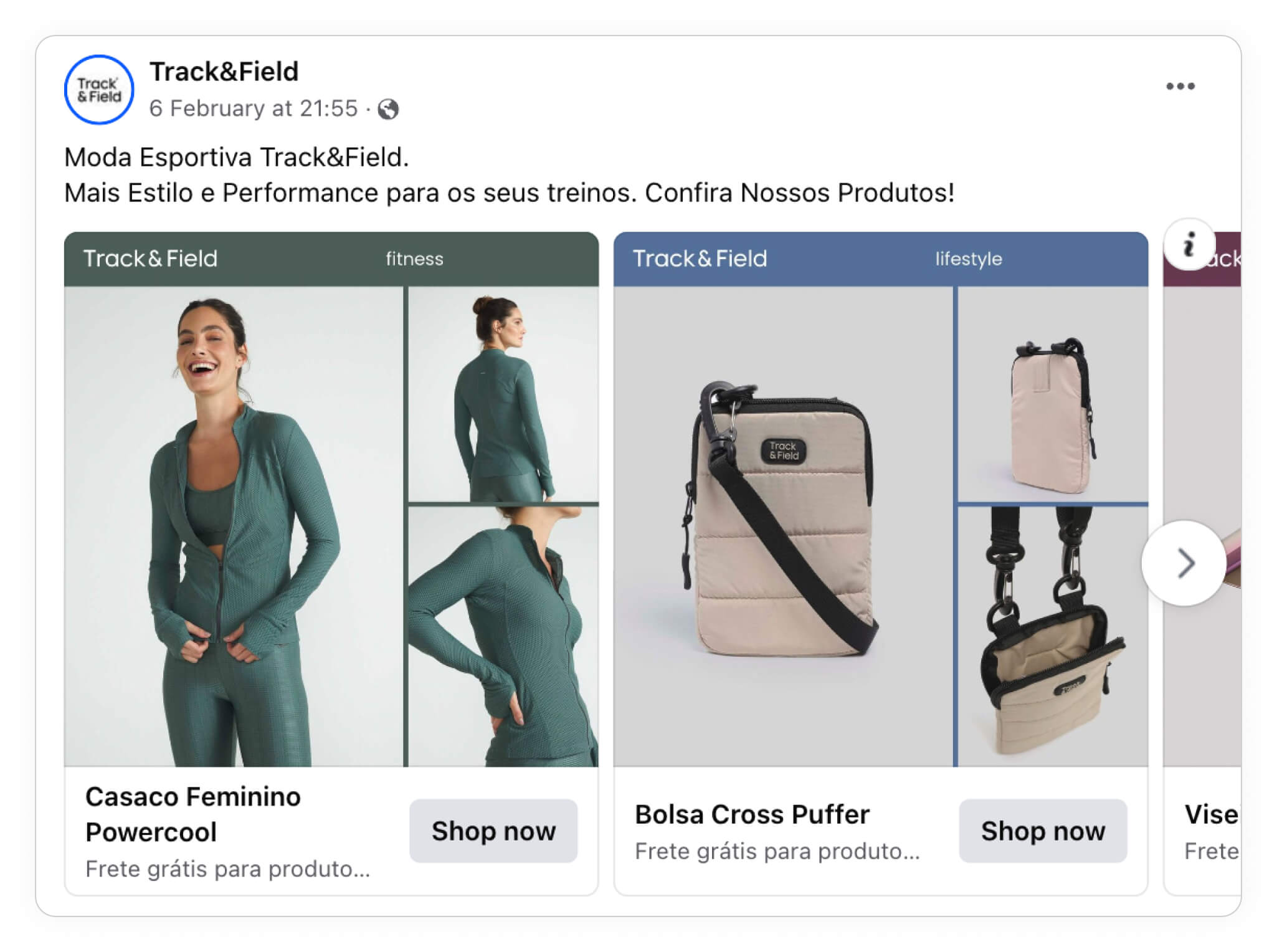
So just remember that you don't need to limit yourself to standard packshots of your products. When showing multiple images, think about using different shots, different modeling poses, and playing around with different bits of product information to make sure your Catalog Ads really stand out from the crowd.
Benefits:
- Using additional images can help you highlight the quality or usefulness of your products.
- Models are a great way to improve the desirability of whatever type of products you're selling.
Disadvantages:
- Not all sports and fitness brands have the resources to have models to wear their products.
Campaigns & Sales for sports & fitness brands
Time-based campaigns can be a great way to hype your products whenever needed.
And the best part is that sports & fitness brands can create campaigns based on time-periods, like holidays or seasons, product sets or categories, or just your most popular products or those that are on sale.
Let's take a look at how other sports and fitness brands are creating Advantage+ Catalog Ad campaigns.
Campaign periods
We all know that there are certain times of the year when virtually everyone is in shopping mode. Namely, we're talking about holidays and events like Black Friday, Cyber Week, or Christmas.
And these campaign periods can be extremely useful for creating compelling Catalog Ads.
Take for instance the following Catalog Ad from Body&Fit, where they've creating a campaign period for Cyber Week. But they don't only mention that their products are on sale because of Cyber Week. They've also designed a background that is relevant to the campaign period too!

Similarly, the following Catalog Ad example from Puma leverages Black Friday as their campaign period. But they went a step further and used Black Friday colors to create an even more relevant Catalog Ad.
They've also included some text to add pricing information, which is another great way to qualify traffic, and made sure to state exactly when their sale ends, which can help create a sense of urgency for the viewer.
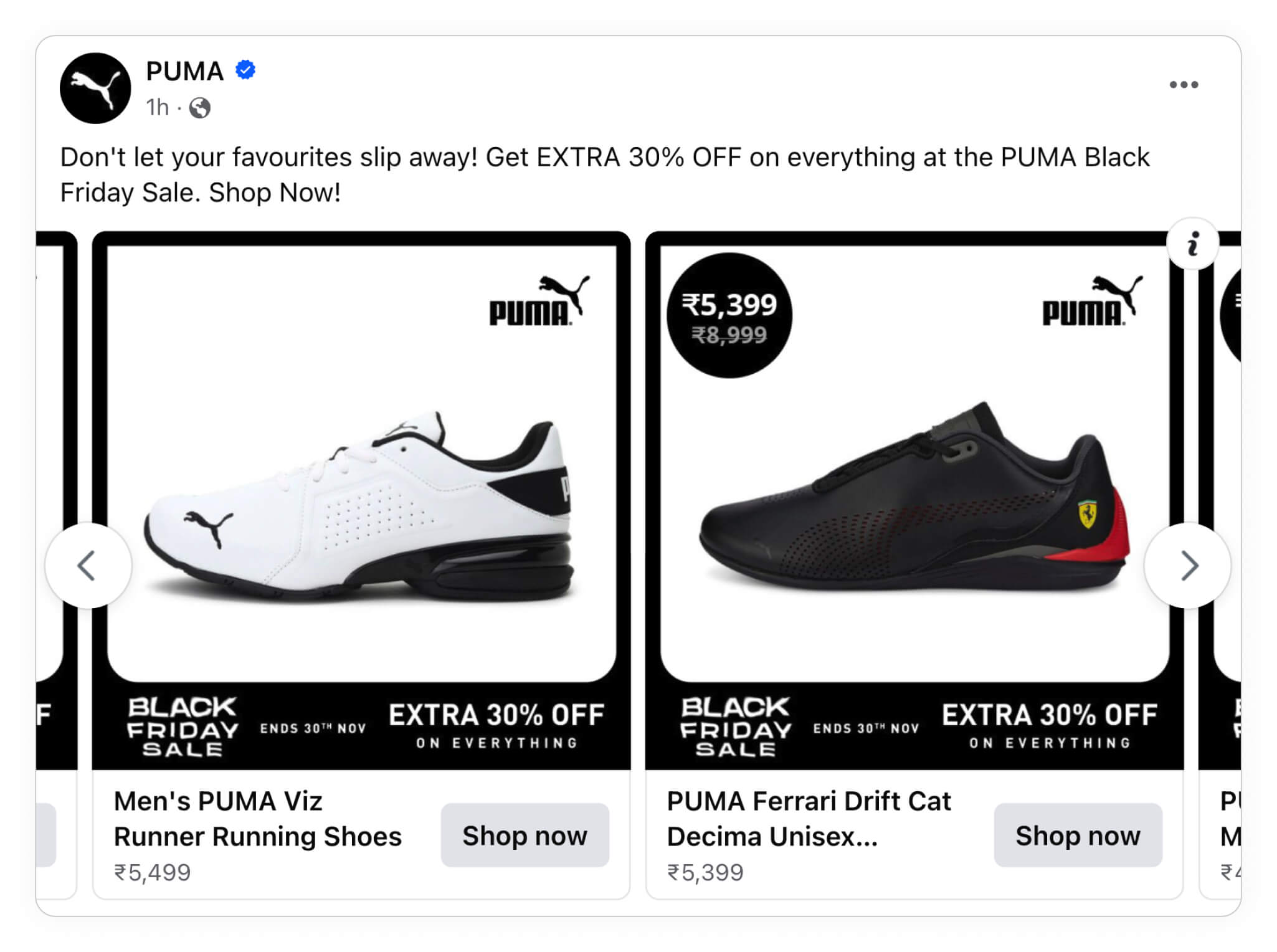
Seasonal sales and time-specific campaigns
Aside from holidays like Black Friday or Cyber Week, sports & fitness brands can also create seasonal sales or time-sensitive campaigns that really amp up the urgency. However, you don't have to actually follow calendar events, you can also create your own time-sensitive sales and campaigns too!
For example, the following Catalog Ad from JD Sports uses a winter deal, which is good because it can be relevant to the time of year, and is only for a limited-time, which can drive more sales.

But we also love the wording they've used for their sale, stating "Up to 50%." This type of wording is a bit vague, and doesn't really state what is on sale or for how much. Therefore, it will elicit a sense of curiosity in the viewer driving them to click-through and shop around to find out.
Gymshark are also good at utilizing Catalog Ads for different festives and seasons.
Below is a german Catalog Ad helping consumers find "christmas presents for her". This is the beauty of Catalog Ads - seeing the product you are most likely to buy with a seasonal design giving you a great reason to buy the product right now:
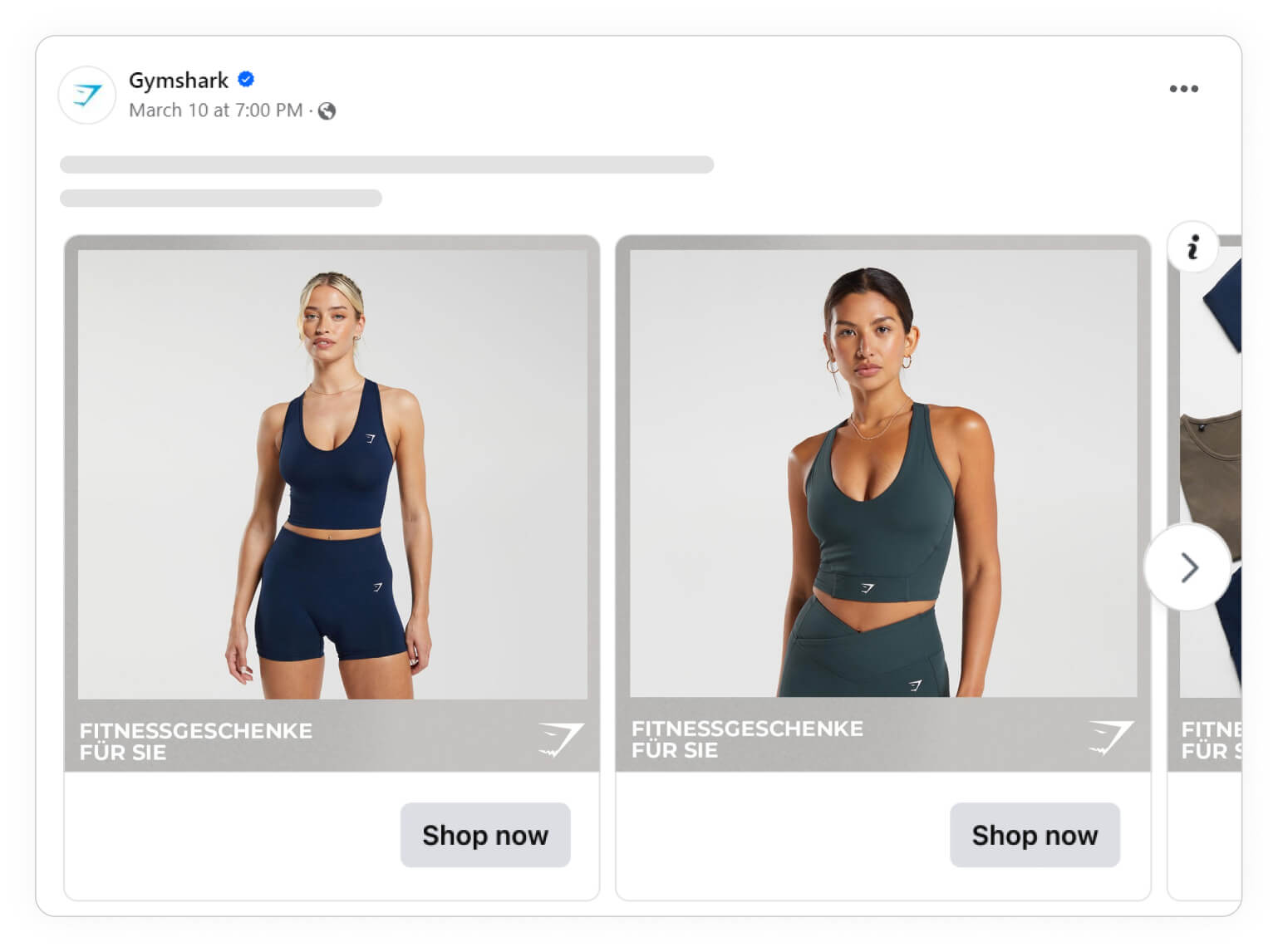
JD Sports invented their own campaign for winter with a discount - whereas Gymshark utilized consumers buying Christmas gifts, but without the discount - both viable and smart tactics.
End of season sales are another great example of time-specific campaigns.
And the following example from Protees is a great example of how you can also create end of season sales, and include a variety of relevant information, such as multiple product images, the product category, discount information, and branding.

Finally, we have another great example of a sports and fitness Catalog Ad based on a "new year, new X" campaign.
What we love about this campaign is that it's easy to run for all sorts of different product sets or categories. So, while this example is based on "new year, new bike," you can also modify it to whatever type of products your brand sells!
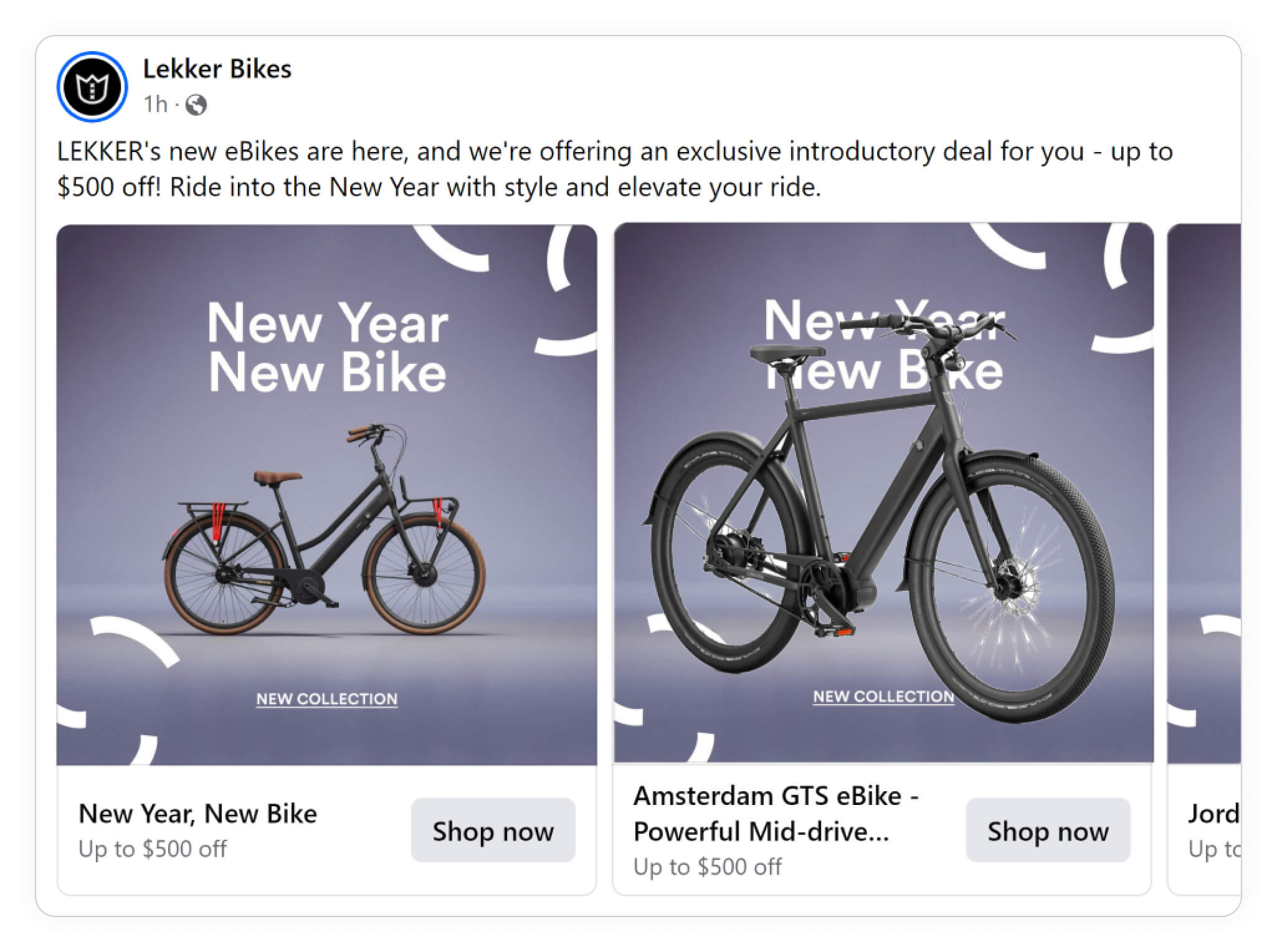
The key takeaway here is that you don't need to limit yourself to traditional limited-time only sales. There are many different ways you can create time-based campaigns that can drive urgency and nudge your viewers into action.
Let's recap!
Benefits:
- Time-based campaigns can help create urgency and drive your viewers to act now.
- Campaign periods can be based on virtually anything from holidays and calendar events to weekly or end of season deals.
- Campaigns can also be based on product sets or categories.
Disadvantages:
- The only real disadvantage of campaigns is that their lifespan is finite so they won't last forever, unlike always-on Catalog Ads.
Always-on sales for sports & fitness brands
Chances are you always have at least some products on sale. And if you do, you should, of course, show them in your Catalog Ads! It can be a great idea to have a special design for all your products on sale.
And you can do it in a million different ways!
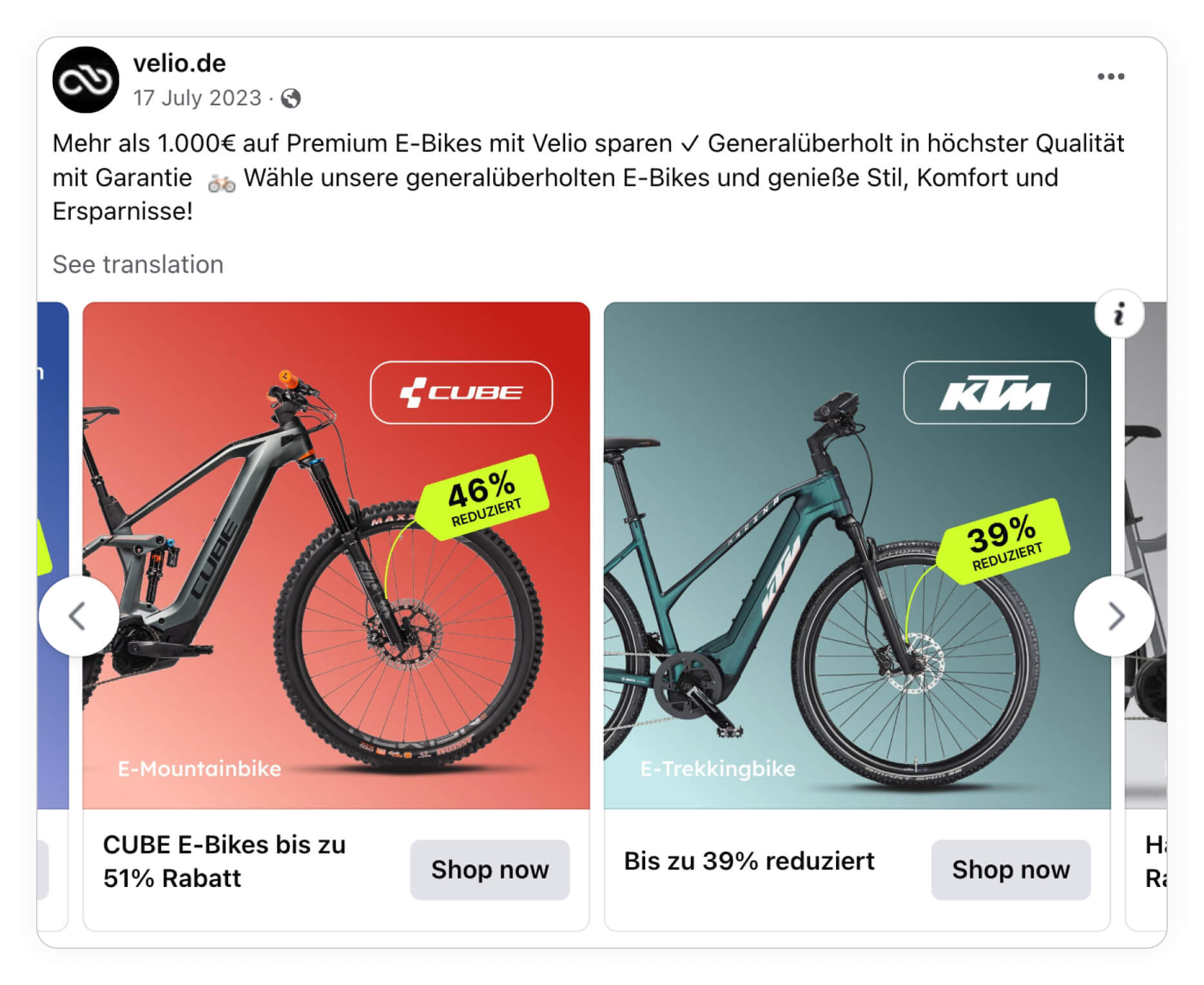
For instance this ad is only showing the percentage saved, BUT, it also includes other relevant information. The logos, brand-colored background, and the brand logo all work together brilliantly! All in all, this is a beautifully executed Catalog Ad that makes good usage of product information. And the pricing information is just the cherry on the top - it binds everything together and gives the ad meaning.
You could easily have a design identical with this just without the price tag for all your products that aren't on sale.
Here's an example from BestSecret giving viewers the opoortunity to "Unlock access to top deals" via their Catalog Ads:

When running always-on Catalog Ads, you can also focus on pricing information to make your offers that more appealing to the audience. One common way of doing this is to use pricing psychology is to show the original price and the reduced price, just like in the ad below.
This ad again combines pricing information with other relevant product information, IE the product name and their logo, which brings everything together into a single effective Catalog Ad.
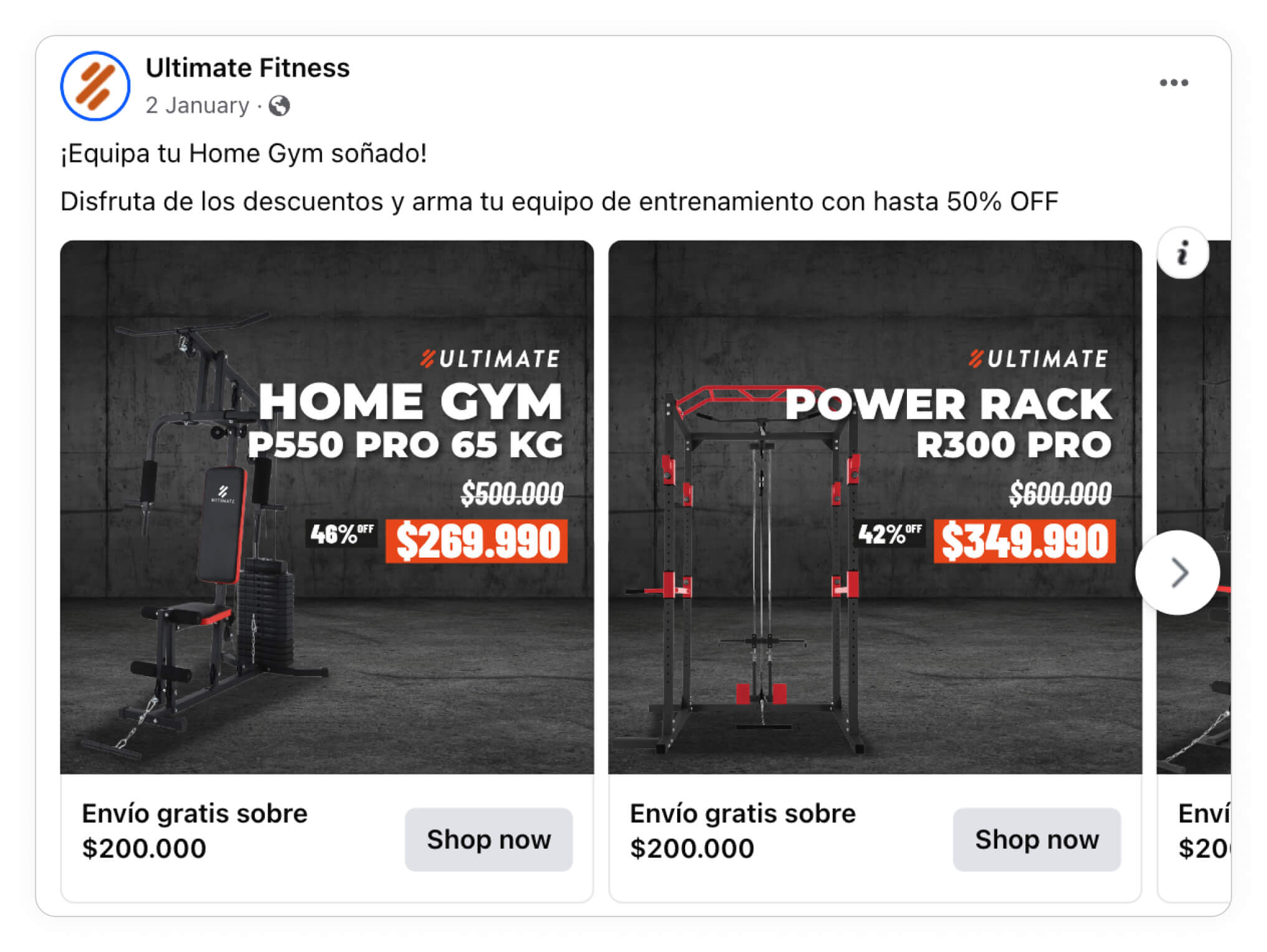
And finally, we have another Catalog Ad example where the advertiser uses product bundles or combos to make their offer more appealing.
You could also get a bit more creative here and try running a BOGO offer, where it's buy one or two, and get one free, which is yet another common and effective ad tactic you'll often see out there.
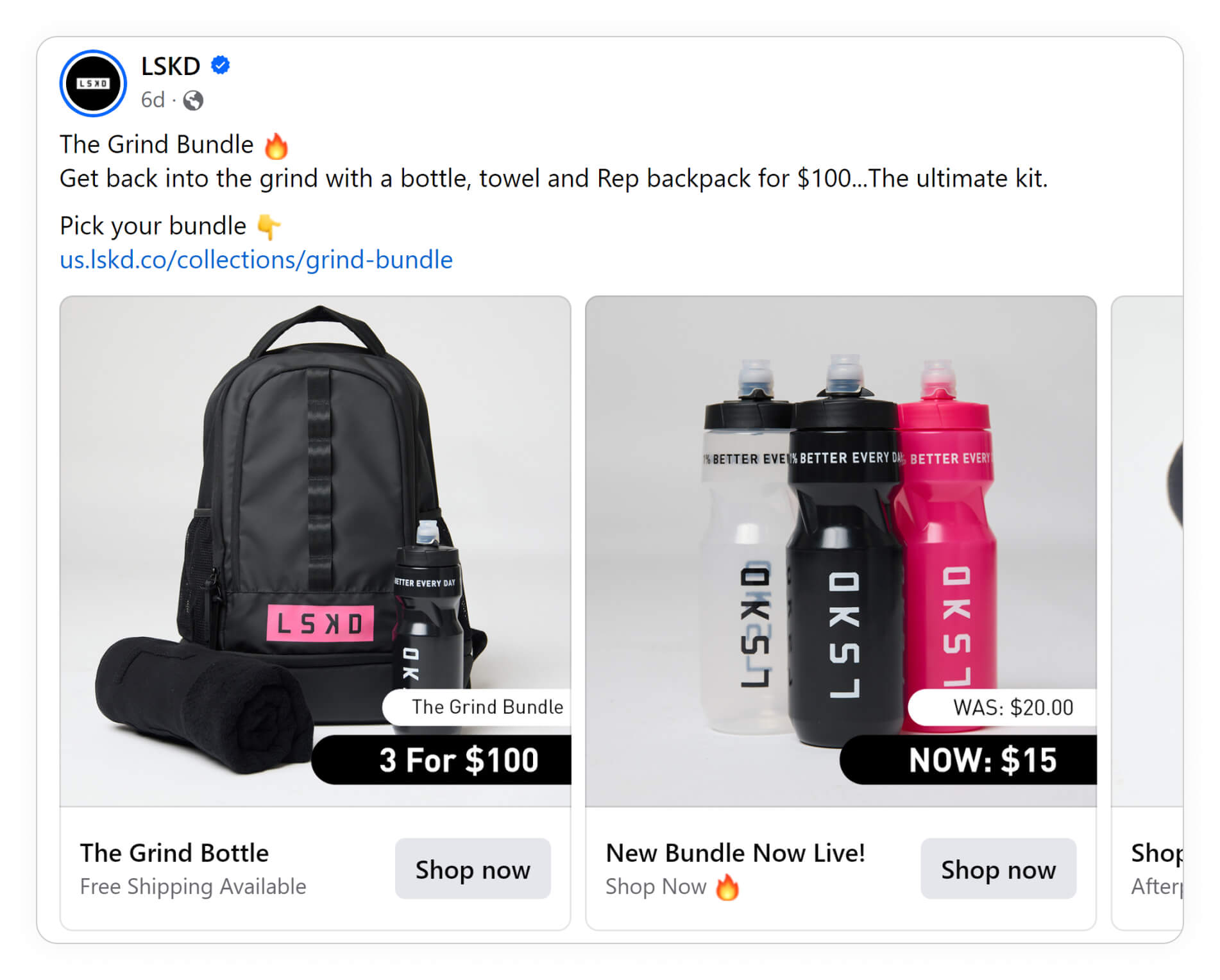
Creating effective sports & fitness Catalog Ads that sell
So, as you can see, there are all sorts of different tricks and tactics you can use to create Advantage+ Catalog Ads for your sports or fitness brand.
The idea, again, is to leverage relevant and valuable information that you already have access to, which allows you to screen and qualify your target audience before they even land on your website.
Of course, not every tactic described here is going to work for your sports & fitness brand and your product.
But the idea is to think outside the box, and use these Catalog Ad examples as inspiration to help you find out what really works!
Just remember to always A/B test your content so that you can refine and perfect your Catalog Ads for the future!
